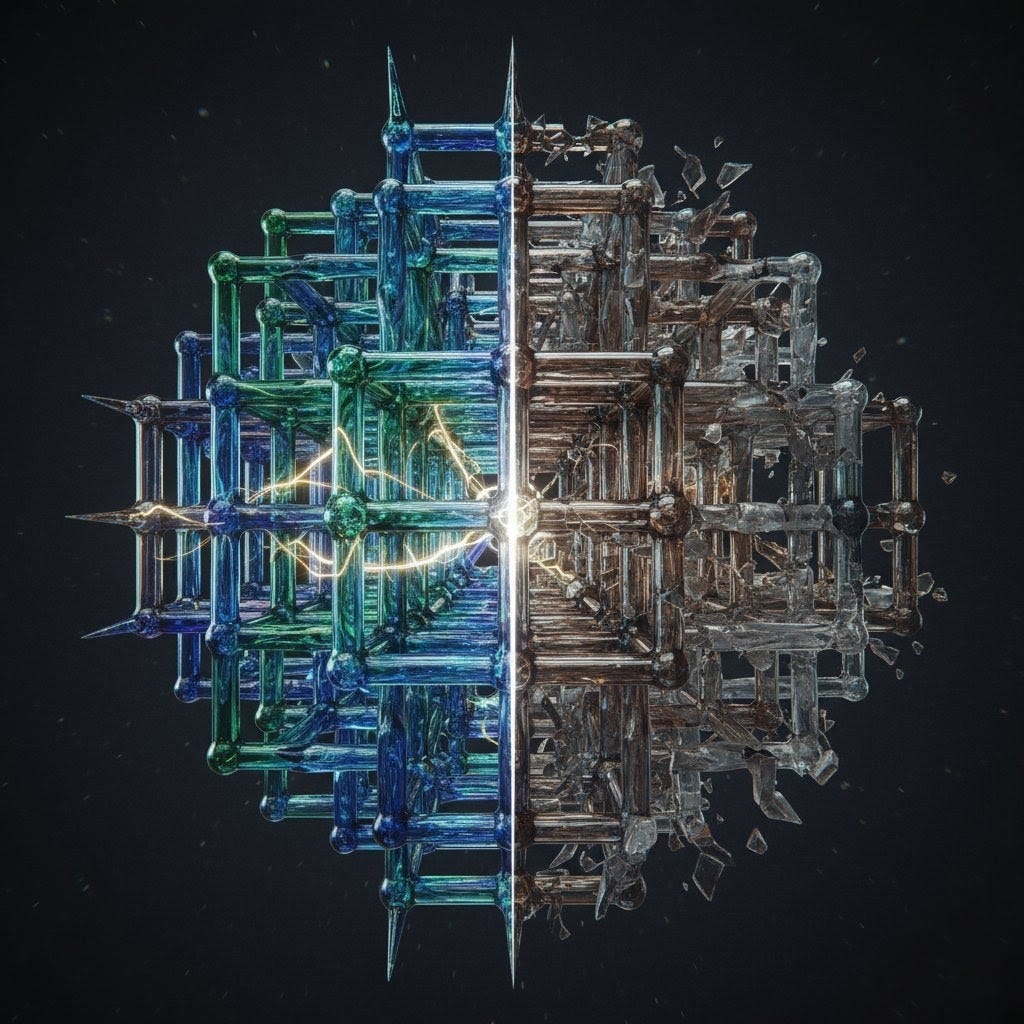We mistake the bridge that stands, the institution that endures, or the body that heals for evidence of inherent strength, as if stability were a default condition. This is a foundational error.
Persistence is not a passive state. It is an active, costly, and continuous achievement against entropic decay. Every entity—biological, social, or technical—requires a constant allocation of resources, a “maintenance budget,” simply to sustain its coherence. Stability is not a given; it is the outcome of ongoing repair.
This single claim reframes our most basic understanding of the world. It provides a new foundation for politics, a new definition of justice, and a new tool for diagnosing why systems—and societies—fail.
1. Being Is Maintenance
Our first mistake is ontological. We see “being” as a noun, a static fact. But persistence is a verb. To exist is not a state but a process: the successful postponement of collapse.
Every entity is in a constant battle with its own decay rate (λ). A body fights cellular degradation, a friendship fights misunderstanding and drift, an infrastructure grid fights friction and load. To persist, each must receive a continuous input of “maintenance” (M)—in the form of energy, attention, resources, or care—that is at least equal to its rate of decay.
This is the “maintenance budget.” It is the literal, quantifiable cost of existence. An organism’s “being” is its metabolic process; a community’s “being” is its social ritual and repair. To be, in the most profound sense, is to be maintained.
2. Governance Is the Allocation of Repair
If this ontological claim is true—if B ≡ M (Being is Maintenance)—then the consequences for politics are immediate and absolute.
The primary function of any governing structure is not, as we are often told, creation, innovation, or expansion. It is the distribution of repair resources. Politics is the system that decides which systems, communities, and infrastructures receive the capacity to persist.
A budget, here, is not just a financial document; it is a moral ledger that records, with mathematical precision, what a society has decided to keep alive and what it has condemned to decay.
Governance is, quite simply, the allocation of repair capacity. This is its first and most important job.
3. Injustice Is Systemic Neglect
This political definition clarifies our understanding of justice and harm. Structural harm does not require active, violent destruction; it can be achieved far more quietly. The simple withdrawal of repair capacity produces a predictable, measurable decay.
This reframes our understanding of neglect. “Neglect” is not a passive failure of attention; it is an active policy instrument.
An unjust society does not just harm its marginalized; it systematically withholds maintenance from them. It is the policy of “redlining” a neighborhood, cutting its maintenance (for schools, roads, healthcare, and security) while knowing its decay rate (λ) is high. The resulting “blight” is not a tragedy; it is the visible evidence of a successful policy.
Injustice, therefore, manifests as the inequitable allocation of maintenance. It is the policy that determines whose lives and communities are sustained and whose are allowed to fail.
4. Collapse Is a Function of Maintenance Deficits
This framework is not just a metaphor; it is a diagnostic and predictive tool. Here, system failure is not a mystery, a tragedy, or an act of God. It is a mathematical function.
A system collapses when its maintenance effort (M) falls below its inherent rate of decay λ. This relationship—B < 0 IFF M < λ—is quantifiable.
It proves that collapse—of an infrastructure grid, a public service, or social trust—is not an unfortunate risk but a mathematical certainty when maintenance deficits are enforced. This framework enables predictive audits of any system.
We can measure the gap between decay and repair, and we can see exactly where power has scheduled a future failure.
5. History Is a Biased Record of Maintenance
If this model is so predictive, why has it been so roundly ignored? Because our entire cultural narrative is designed to hide it.
Traditional historiography is complicit in this erasure. It is a history of creation and disruption, not a history of maintenance. It privileges the singular moments and the “great men” who broke or built things—the generals, the inventors, the kings.
This narrative systematically erases the continuous, quiet, and essential labor of maintenance—the labor disproportionately performed by women, marginalized communities, and service workers who actually held societies together. The quartermaster who maintained the supply line, the nurse who mended the body, the scribe who preserved the text, the caregiver who sustained the community—they are the invisible protagonists of history.
This erasure is not incidental; it is constitutive. The history curriculum, in what it chooses to remember and what it chooses to forget, is itself an act of selective maintenance. It reproduces the very allocation bias that governs our political economies, determining which pasts remain legible and which are left to decay.
The Architecture of Persistence
And so, the framework is complete.
To be is to be maintained.
Persistence is not an inherent design feature but rather a continuous, resource-intensive, and widely distributed accomplishment.
The allocation of repair capacity is not a subordinate bureaucratic function; it represents the concealed framework of power, justice, and historical memory.
When Conscience Runs Out of Time: Toward an Ethics of Maintenance
Our inherited moral frameworks were built for a smaller world, one where people could see the results of their choices and take responsibility. That world no longer exists. Today, automated systems shape our lives. Algorithms determine creditworthiness, logistics networks govern scarcity, and content filters decide what can be said. These systems operate faster than human thought, often without any specific intention driving them.





